AMD A10-5800K & A8-5600K Review: Trinity on the Desktop, Part 2
by Anand Lal Shimpi on October 2, 2012 1:45 AM ESTContent Creation Performance
Adobe Photoshop CS4
To measure performance under Photoshop CS4 we turn to the Retouch Artists’ Speed Test. The test does basic photo editing; there are a couple of color space conversions, many layer creations, color curve adjustment, image and canvas size adjustment, unsharp mask, and finally a gaussian blur performed on the entire image.
The whole process is timed and thanks to the use of Intel's X25-M SSD as our test bed hard drive, performance is far more predictable than back when we used to test on mechanical disks.
Time is reported in seconds and the lower numbers mean better performance. The test is multithreaded and can hit all four cores in a quad-core machine.
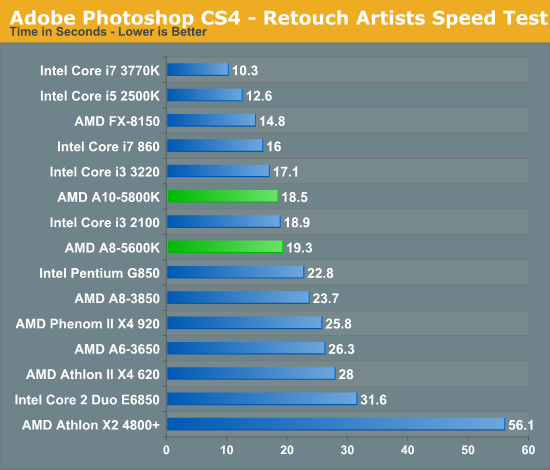
Our Photoshop workload still runs better on Intel hardware, but the gap in performance between the 5800K and 3220 is smaller than it was between the FX-8150 and 2500K last year. While Bulldozer was pretty much unrecommendable, Trinity approaches tradeoff territory.
3dsmax 9 & POV-ray
Today's desktop processors are more than fast enough to do professional level 3D rendering at home. To look at performance under 3dsmax we ran the SPECapc 3dsmax 8 benchmark (only the CPU rendering tests) under 3dsmax 9 SP1. The results reported are the rendering composite scores.
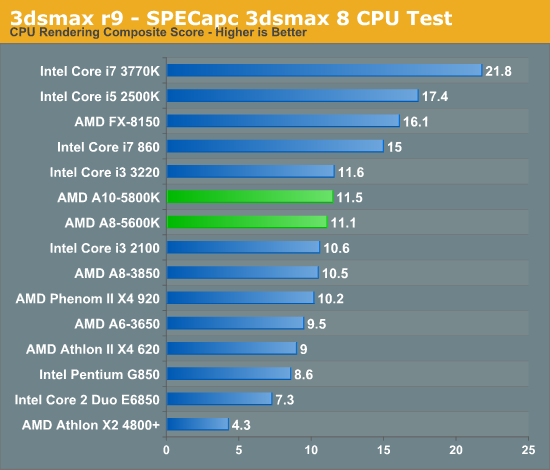
Once again in a heavily threaded FP benchmark, the A10 and Core i3 perform very similarly. POV-Ray is another example of this below:
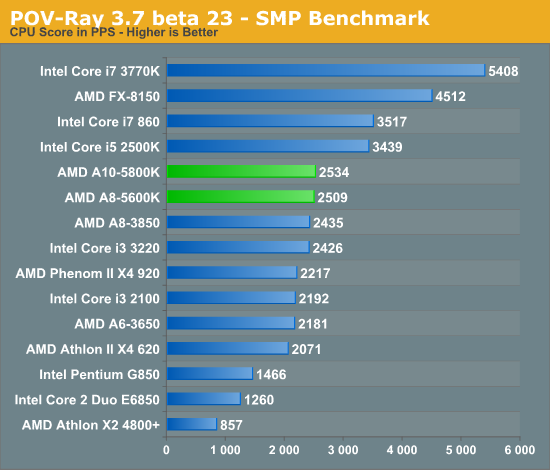
File Compression/Decompression Performance
Par2 is an application used for reconstructing downloaded archives. It can generate parity data from a given archive and later use it to recover the archive
Chuchusoft took the source code of par2cmdline 0.4 and parallelized it using Intel’s Threading Building Blocks 2.1. The result is a version of par2cmdline that can spawn multiple threads to repair par2 archives. For this test we took a 708MB archive, corrupted nearly 60MB of it, and used the multithreaded par2cmdline to recover it. The scores reported are the repair and recover time in seconds.
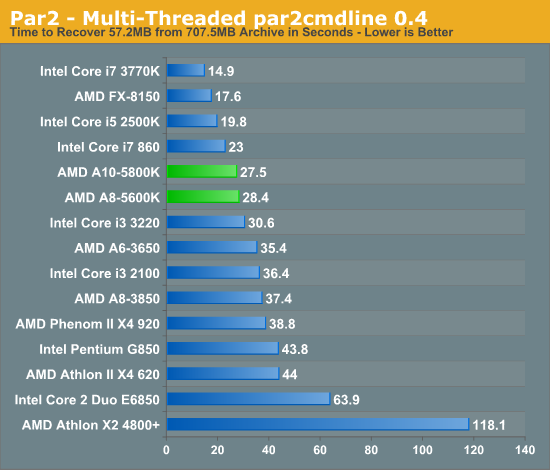
Our multithreaded Par2 recovery test shows AMD with a small advantage over the Core i3 3220, although it obviously can't touch any of the more expensive quad-core parts.
Excel Math Performance
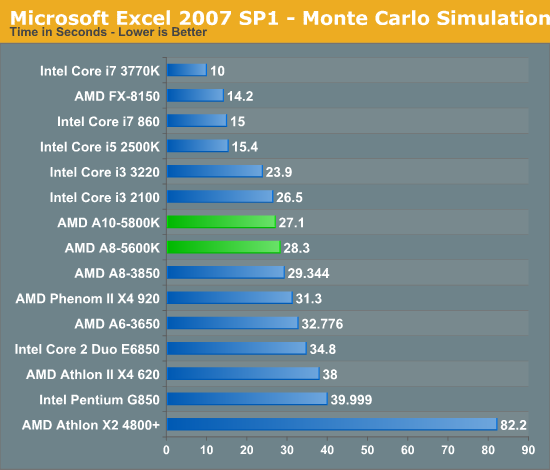
Not all heavily threaded FP applications are easy wins for AMD. In our Monte Carlo simulation benchmark the 3220 manages a decent lead over the A10-5800K.
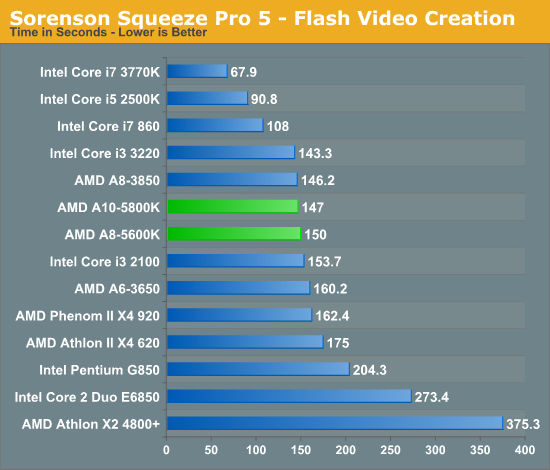
Our old Sorenson Squeeze test is one area where we see a slight regression compared to Llano. Like I mentioned earlier, this isn't super common but it does happen from time to time given the dramatic architecture difference between Llano and Trinity.










178 Comments
View All Comments
Crono - Tuesday, October 2, 2012 - link
It's good to finally see pricing on Trinity.Looks like AMD is still competitive at lower price points for Video transcoding performance, which is good news for me and others who's highest CPU workloads are mostly video editing.
But even for gaming the A10-5800/K doesn't look too bad for $122 chips.
Glad to see it isn't quite "Bulldozer" all over again. I need to build a new system for Windows 8 and Trinity looks promising for a budget to mid range build.
ac2 - Tuesday, October 2, 2012 - link
Big deal...Just look at pg 2, the single threaded performance of the A10 is lower than a friggin Pentium G850
Pg 3 Sysmark, only slightly ahead of the Pentium even with 2 additional Integer cores
I wish Anand had included the Pentium G850 power comparison as well though at 65W vs 100W TDP we can be sure which way that will swing...
And the G850 costs a little more than HALF the A10 suggested price... That puts a $70 saving towards a discrete graphics card, which, as per pg 6 should result in a much better gaming performance as well...
StevoLincolnite - Tuesday, October 2, 2012 - link
It's also slower than an old Core 2 Quad Q6600 overclocked to 3.6ghz+ which was released in 2007 both in single threaded and multi-threaded tasks.However, what I would like to see is some under-volting tests to see how low they can go in terms of TDP as AMD has always been incredibly conservative (Even on the GPU side) with voltages, would be excellent in a Mini-ITX rig without the need for a dedicated GPU.
MrMilli - Tuesday, October 2, 2012 - link
http://www.computerbase.de/artikel/prozessoren/201...Belard - Tuesday, October 2, 2012 - link
Really cool how the performance charts are NOT static.Ah, German technology. :)
phillock - Friday, January 26, 2018 - link
I think there is very little need for raw single-threaded performance increases in consumer-level "general computation" processors (e.g. few-core x86 processors). So who cares if we don't have a second intel? What we do need are better ways of extracting performance from multiple cores, and from the massively parallel architectures found in GPUs. Part of the equation is ensuring that these two paradigms are pervasive, and therefore,https://audiomanagerapp.wordpress.com/2017/10/11/a... from a big-picture point-of-view, AMD really *is* pushing things forward with TrinityB3an - Tuesday, October 2, 2012 - link
Trinity truly is embarrassingly slow. I think it should be even cheaper for this performance level. And it's also disappointing that Intel have no performance competition AT ALL from AMD. We need this for some real progression to be made in desktop CPU's and also drive prices down at the high end.IKeelU - Tuesday, October 2, 2012 - link
What kind of progress are you talking about? Power efficiency? Raw general computing performance? Progress comes in many forms.I think there is very little need for raw single-threaded performance increases in consumer-level "general computation" processors (e.g. few-core x86 processors). So who cares if we don't have a second intel? What we do need are better ways of extracting performance from multiple cores, and from the massively parallel architectures found in GPUs. Part of the equation is ensuring that these two paradigms are pervasive, and therefore, from a big-picture point-of-view, AMD really *is* pushing things forward with Trinity.
Belard - Tuesday, October 2, 2012 - link
AMD's progress is about 2 years behind. While this is somewhat intel's fault by illegal competitive practices which in turn kept AMD from profiting as much as they could have during the Athlon64~X2 era.AMD has done a lot of things wrong and would take at least 2 years to sort out... if ever. FM2 is no better than FM1 and not cross compatible. Neither is compatible with Socket AM3 and nothing AMD has on the market even supports PCIe 3.0.
Compared to buying an intel i3-something system, in which you can upgrade to an i7-something easily. AMD has a mess on their hands and I suspect part of their performance problems could also be rooted in their chipsets. (Across the board, the performance hits a wall). Yeah, for a notebook - the powerful GPU part comes into play. And both intel i3 and Trinity is more than powerful enough for MOST people. hell, I'm still running on a Q6600 at 2.4Ghz and it does quite well (going i5-3570 this weekend)... But for those who want their money's worth when performance counts, AMD is not in the game.
The performance from AMD has to be consistent, and its not. The heat is not good along with the cheap fans they include that are noisy and should be replaced with a good $20~50 cooler. Meanwhile intel CPUs are running cooler and their fans are very quiet.
So as of today, in general - it costs more to get an AMD. I really want AMD to do well, I've sold lots of AMD systems in the past.
Origin64 - Wednesday, October 3, 2012 - link
About PCIe 3.0, nobody needs that. 2.0 * 8 is enough to drive every card on the market with maybe 2% performance loss, which is within the error margin of every benchmark. To keep prices low, of course they're not going to add extra features that nobody needs. I think it's a smart move.Other than that, I agree. AMD hasn't been doing well price-performance wise the last two years. I have a Phenom II, and when they were released they were still competitive, for the price and the time, but the last two generations have seen no singlethreaded performance increase and cost about the same.